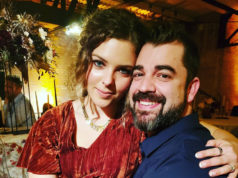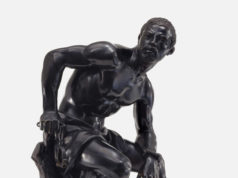To a lot of viewers and critics, the title Lost has become a bad pun on the show itself.
Over the course of the ABC drama’s searing first two seasons and now the beginning of the third, here is what we know for certain: that a commercial airplane split in half in mid-air and deposited its flesh-and-bone cargo in the middle of nowhere on a weird, scary island inhabited by a group of baddies called The Others, and that everything we think we know may be false.
The Darwinian premise drives most of the action. In trying to survive, the castaways exchange gunfire, endure powerful hallucinations, and try to avoid being eaten — or worse — by a sentient, shape-shifting beast lovingly referred to by the show’s legions of hardcore fans as “Smokey.”
Created by J.J. Abrams and Damon Lindelof, Lost didn’t always used to be a glorified, dramatized version of Survivor, CBS’s long-running reality tv show that is also set on a island and whose sinewy cast members also enjoy running around half-nekkid. Lost once had a soul, mainly in the form of a large vigilante Catholic priest named Mr. Eko. To him (Adewale Akinnuoye-Agbaje), the island wasn’t a final resting place but his destiny. That his destiny, evidently, was to rest finally on the island has been the cruelest plot twist in a string of cruel, cheap surprises. Viewers have spoken. They’re tuning out in droves.
The only other character who believes that he was fated to wash up on shore is John Locke. But at the end of season two, he had a crisis in faith and is only now returning to his former, spiritual self. Locke or no Locke, though, the general consensus in the industry is that Lost is beyond saving. Barring some miracle, there will be no fourth season.
Too bad for author and former Fort Worthian Christian Piatt, whose book about Lost and its parallels to certain tenets of Christianity, came out a couple of months ago, before the beginning of season three. Had season two ended better and had the current season started off decently, Lost: A Search for Meaning might have been hot property. Now, unfortunately, the book doesn’t resonate much.
When writing it, Piatt smartly avoided getting tied up in the show’s knotted symbolism. A good thing, considering that even Abrams and Lindelof don’t appear to know where the story’s going. Piatt, a devout Christian and religion columnist for The Pueblo Chieftain, leaves the debates over minutiae to the Lost geeks and their web sites. He has bigger fish to fry: “In as much as Christendom has distorted Christianity throughout history,” he writes (his emphasis), “we are charged as followers of Christ to respond to this as an unjust misrepresentation of the faith. Further, we are compelled to act on behalf of those who are marginalized, challenging the disparities created by otherness and the suffering it brings with it.”
Piatt puts his money where his mouth is. When he lived here, he worked for Samaritan House, a local nonprofit that provides support for AIDS victims. Based on his book and many others like it, including Taking the Red Pill: Science, Philosophy, and Religion in The Matrix and James Bond in the 21st Century: Why We Still Need 007, popular culture can be an effective way to reach the unwashed. Like most shows and films, the characters on Lost are all types, and in Search for Meaning, they all represent either us and people we know or parts of us that could use some betterment.
A show like Lost, with its open-endedness and oddly engaging approach to storytelling, opens itself to all kinds of impositions of meaning, including Piatt’s. The castaways follow one dead end after another, and as we follow them — which is hard not to do; the acting is superlative — we can approximate and compartmentalize their dread. Their navigating the island is not unlike our navigating life in post-9/11 America. The meta-narrative, we discover, isn’t surviving or getting anywhere. It’s instigating and tracking changes in perspectives.
Lost, with its compelling cinematic power, makes for a perfect soapbox, especially for a call to tolerance like Piatt’s. Even though ratings are down, the show remains immensely popular, and the characters are some of the most intriguing — and biblical — on tv. There’s the Christ figure, Jack (Matthew Fox), the hardened neurosurgeon and reluctant leader of the group. There’s the Doubting Thomas, Locke (Terry O’Quinn). There’s the Virgin Mary, Claire (Emilie de Ravin), and so on. The leap from The Greatest Story Ever Told to Lost may be as short as Piatt argues it is.
The author, unfortunately, structures his book so poorly that whatever insights he may have offered go missing. Every chapter consists of a brief exposition of a certain episode followed by heavy theological scholarship. But there are miles of pages between his descriptions of the action on the island and his larger, corresponding parallels to history and spirituality. You get the uneasy feeling that he mashed two separate term papers — one on Lost, the other on lost Christianity — into one book. There’s often little or no connective linguistic tissue between the two subjects.
On a related note, the University Village Starbucks will host Art Hop 2007, a silent art auction on March 31 that is being held to raise funds for Samaritan House. For more information, call Beth Boag at 817-332-9748 or 817-927-7899. — Anthony Mariani
Years ago Ballet Russes and American Ballet Theater gave many folks their first taste of classical dance with touring shows that had something for everyone. A piece with artistic depth popped up somewhere on the program, but most of it was bravura bits and pieces followed by a frothy finale for the whole company. The lighthearted approach won countless friends for dance.
Once a year Texas Ballet Theater reverts to the repertory format, and last week’s program in Bass Performance Hall saluted those bygone days with a fun-filled evening called Romance to Ragtime. True to the concept, one ballet had meat on its bones, a revival of director Ben Stevenson’s atmospheric setting of Richard Strauss’ Last Four Songs. Set under what looked like a giant silk parachute gathered in uneven swags — lights turning its folds from white to dove gray — the dancers moved in solemn, slow formations, their white leotards stark against a black backdrop.
In the final moments, as the soprano sang “How exhausted we are with our wanderings / Can this then be death?,” the dancers sank gently, slowly onto their backs. The overhead fabric drifted down to create individual tombs as the lights dimmed and the curtain fell. An adagio tour de force for eight dancers, the ballet seemed static and unconvincing when seen here a few seasons back, but Stevenson’s company has matured, and the performance now is spellbinding.
Melissa Givens sang the punishing vocal lines, as demanding as any operatic aria, and barely hung on in the heroic surges of the opening section. She sounded strident in both performances I saw, but settled down for the remainder of the work.
For show pieces, the company gave us Stevenson’s version of the pas de deux from Benjmin Britten’s Prince of the Pagodas, and Michael Fokine’s Dying Swan. Jayme Autrey Griffith and Andre Silva danced the Britten excerpt with engaging showmanship that earned a hearty ovation. (Unfortunately, Griffith tore a calf muscle later in the evening and will be sidelined the rest of the season.) On Sunday, the Britten piece was replaced by Stevenson’s Vivaldi Variations, with Carolyn Judson joining Silva in the fast-paced music. Silva wowed everyone with his incredible turns, and for the first time in my hearing, shouts for an encore were mixed with the bravos when he finished.
The Dying Swan, an Anna Pavlova specialty from early last century, depends more on fluid arms than nimble footwork for effect. Enrica GuanaTseng’s outstretched limbs undulated as if they had no bones as her hapless bird came to its gentle end, and she too, won solid applause.
For the crowd-pleasing finale, Tim O’Keefe’s new Ragtime Dance, set to Scott Joplin’s joyous music, brought Broadway to ballet in a big way. You’d think O’Keefe would run out of ideas setting seven pieces in the same idiom, but the ballet bubbled with fresh material all the way through. The women in flapper-like dresses and low-heeled shoes, the men in white shirts with arm bands, vests, black trousers, and spats, evoked an era of innocent fun and tireless energy that was irresistible.
Thomas Kilps had the Maple Leaf Rag to himself and gave a high-voltage performance that had style and charm. Julie Gumbinner and Lucas Priolo, usually seen as the romantic leads in TBT’s full-length ballets, appeared in shorter sequences, both in Four Last Songs and Ragtime. (This may be the last we see of Gumbinner for a while. She’s expecting a child in September, which leaves performances in the upcoming Alice in Wonderland problematic and next season’s opening months a question mark.)
Music director Jack Buckhannan led a seven-man ensemble from a piano upstage, in arrangements of the Joplin piano music by Randol Alan Bass. For the rest of the program he conducted the Fort Worth Symphony in the pit with sympathetic understanding of the music and the dancers’ needs. The Strauss songs had rough edges, but everything else was well in hand. — Leonard Eureka
Contact Kultur at kultur@fwweekly.com.











